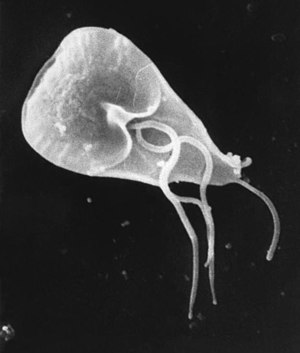Giardia intestinalis
| Giardia intestinalis | ||||||||||||
|---|---|---|---|---|---|---|---|---|---|---|---|---|

Giardia intestinalis |
||||||||||||
| Systematics | ||||||||||||
|
||||||||||||
| Scientific name | ||||||||||||
| Giardia intestinalis | ||||||||||||
| Kofoid & Christiansen , 1915 |
Giardia intestinalis (synonyms: G. lamblia , G. duodenalis ; Lamblia intestinalis , Cercomonas intestinalis ) is a unicellular parasite from the genus Giardia , humans (→ giardiasis ), other mammals (→ giardiosis of dogs , giardiosis of cats ), amphibians , Reptiles and birds. The pear-shaped or spoon-shaped flagellate with eight flagella is named after Alfred Mathieu Giard and Vilém Dušan Lambl . It usually reachesthe human intestinevia contaminated surface water, which contains its permanent forms ( cysts ), or - less often - via contact with flies. In cats and chinchillas , Giardia intestinalis is one of the parasites that is most frequently found in fecal examinations.
features
Trophozoites are the active forms of the unicellular organism in the intestine and only they reproduce. They are oval, elongated and about 9–20 µm long and 5–12 µm wide. Each individual has two nuclei and four pairs of flagella , two of which arise in the middle of the cell and two more from the side. In addition, the trophozoites have an adhesive disc on the ventral side with which they are held in the intestinal epithelium .
Cysts are permanent forms with a protective cover and are very resistant to environmental influences. They are about 8-15 µm × 7-10 µm in size. Cysts are excreted by infected organisms and can survive for up to four months in surface water (such as lakes). In the intestine, these are converted back into trophozoites.
Special features of Giardia intestinalis are:
- Giardia intestinalis has no mitochondria and no peroxisomes , but mitosomes that synthesize iron-sulfur clusters and genetic material that contains mitochondrial genes. It is believed that Giardia lost their mitochondria again in the course of evolution .
- The genome is very variable. It contains 12 million to about 80 million base pairs, which are distributed over 8 to 50 chromosomes .
- Sexual maturation ( meiosis ) has never been observed, but genes for this process have been found.
- In the jejunum only trophozoites are, but in the ileum only cysts. A lack of cholesterol is responsible for the fact that the trophozoite surface can no longer be formed. This leads to cyst formation ( encystation ).
Different genotypes can now be distinguished using molecular biological techniques . While the genotypes A (partly also subdivided into the subgroups AI, AII) and B apparently have a zoonotic potential and can infect humans as well as dogs and cats, for example, the other genotypes are apparently host-specific. Genotype C and D occur in dogs (D also in cats), genotype E in ungulates , genotype F in cats and genotype G in rodents. Type B in particular is observed in chinchillas.
Epidemiology
About 10% of the world's population are infected with lamblia. Children in particular are affected here. It is the most common protozoal infection among travelers to the tropics .
illness
- → Main article: Giardiasis , giardiosis of the dog
The infection with lamblia usually goes unnoticed. Sometimes patients complain of bloating, tenderness around the navel, and / or diarrhea. Weight loss is also not uncommon.
For the therapy is metronidazole or paromomycin used in treatment failure and albendazole , nitazoxanide or chloroquine .
Legal
In Germany, direct or indirect evidence of Giardia lamblia must be reported by name in accordance with Section 7 of the Infection Protection Act , provided the evidence indicates an acute infection. However, there is no obligation to register in Austria and Switzerland.
Individual evidence
- ^ Giardia infections ( Memento from January 9, 2015 in the Internet Archive )
- ↑ Nico Pantchev et al .: Endoparasitoses in small mammals from private keeping and hedgehogs. Tierärztl Prax 33 (K) (2005), pp. 296–306.
- ↑ Dieter Barutzki et al .: The dog giardiosis - a widespread disease. In: Kleintier Konkret S1 (2008), pp. 17–23.
- ↑ D. Jaros, W. Zygner, S. Jaros, H. Wedrychowicz: Detection of Giardia intestinalis assemblages A, B and D in domestic cats from Warsaw, Poland. In: Polish journal of microbiology / Polskie Towarzystwo Mikrobiologów = The Polish Society of Microbiologists. Volume 60, Number 3, 2011, pp. 259-263, ISSN 1733-1331 . PMID 22184934 .
- ^ Marianne Abele-Horn: Antimicrobial Therapy. Decision support for the treatment and prophylaxis of infectious diseases. With the collaboration of Werner Heinz, Hartwig Klinker, Johann Schurz and August Stich, 2nd, revised and expanded edition. Peter Wiehl, Marburg 2009, ISBN 978-3-927219-14-4 , p. 292.
Web links
- Giardiasis - information from the Robert Koch Institute
- Tropical Institute of the University of Basel on Giardia intestinalis
